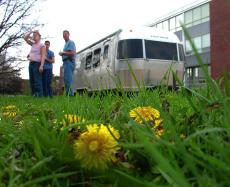Partyin’ on the highway

Hannah Huston, transferring sophomore in LAS, searches for the Quad on Saturday afternoon with her parents, Toni and Greg of Chicago. The family was disappointed to find the air stream trailer locked when they attempted to explore it. Amelia Moore
April 24, 2006
Fifty years ago, federal legislation was signed that changed the way America traveled forever. On June 29, 1956, the U.S. Interstate Highway System, one of the biggest engineering feats in the nation’s history, became a realistic endeavor.
The Illinois Department of Transportation is participating in a nationwide celebration of the 50-year anniversary of the Interstate System this summer. At the end of last semester, the department approached the University looking to create a traveling display commemorating the anniversary.
The result was a campus-wide design competition open to all University students, faculty and staff, sponsored by the department and organized by a committee of faculty from the Department of Civil and Environmental Engineering, the School of Art and Design and the Krannert Art Museum.
It was the organizing committee that decided the display would travel in an Airstream trailer and join a national convoy of vehicles traveling across the country on the interstate system in June. The convoy is part of the national anniversary celebration and begins in San Francisco and ends in Washington D.C. It will pass through Illinois on Interstate 80 in Ottawa, Ill. on June 24.
The competition winners, Rose Marshack, visiting artist and technology integration specialist, Rick Valentin, graduate student and Steve Kostell, University art and design instructor, were announced March 29. The winning team was actually a combination of two separate entries, but after the judges noticed the similarities in the entries they combined them and awarded each team their own $1,000 prize. Kostell had originally entered the competition alone, but is now the team leader of the combined groups.
Get The Daily Illini in your inbox!
David Weightman, director of the School of Art and Design, was on the organizing committee and pointed out what the two winning teams had in common.
“One element was recording conversations with people who had been affected by the interstate, either through leisure experiences or had participated in building it,” Weightman said. “Then they both had the idea of having an immersive 3-D experience.”
The silver-colored Airstream trailer that will be making the historic cross-country journey is currently parked outside the Krannert Art Museum. It is empty now, but won’t be for long. Its 28 feet of linoleum floors and bare aluminum walls will soon be hidden by video and audio equipment, computer screens, a video recording booth, a wall-size main screen, and an information and historical background kiosk, which are all part of the winning concept, titled “Roadside Conversations: Ordinary People, Extraordinary Stories.”
“We’ll ask people to display their own stories and then other people can go through them and navigate through their stories,” Valentin said. “It’s just finding unique voices that maybe you wouldn’t get in a mainstream documentary . we’ll encourage people to come and contribute and be a part of it.”
The design team has set up a Web site with all the information on how to submit a personal Interstate-related story either over the phone, via e-mail or recorded on video. As the Airstream trailer travels with the national convoy and makes stops along the way, Valentin, Marshack and Kostell hope to invite visitors to the trailer, record their stories and interact with the display.
“I think we want to fill this Airstream with as many things to look at as possible,” Marshack said.
Both Valentin and Marshack have backgrounds in computer science and have built off of their own previous computer software to create the new software and programs that will be used in the computer displays. They will also be incorporating 3-D technology that has been developed at the Krannert Museum and the Beckman Institute.
Kathleen Harleman, director of the Krannert Art Museum and member of the organizing committee, said she was excited about the partnerships that have grown between the different areas of study on campus and continue to develop with this project.
“The enthusiasm behind the relationship between the museum and art and design and the College of Engineering is really great,” Harleman said. “I hope there will be future projects together.”
Exploring and using the new 3-D technology in engaging ways is one of the key elements of the display. Marshack, who coordinates the 3-D CANVAS in the basement of the Krannert Museum, is very interested in getting feedback from visitors who interact with the 3-D display.
“I hope that people who see this technology will go ‘Wow, that’s so cool. I’m going to build on it,’ or ‘I have better ideas,'” Marshack said. “Anyone can download it and add on to it.”
The design team stressed that the main part of their display will be the interactivity between the viewers and the project. As the design plans stand, visitors to the trailer will use a computer to navigate through a database of collected stories and select the ones they find appealing. The story might be visual or audio, and have a video component or artwork attached. Visitors are also welcome to contribute ideas on improving the system or give advice on what else to include in the project.
From his experience, Valentin said the most intriguing presentations include viewer participation, where they can actually contribute or control the display content. He believes “Roadside Conversations” has what it takes to attract a wide audience and hold their attention.
“I think it has the potential to be interesting to a lot of different people, different walks of life,” Valentin said. “Everyone loves talking about their experiences and this is a way to get a large group of people to participate in that.”






